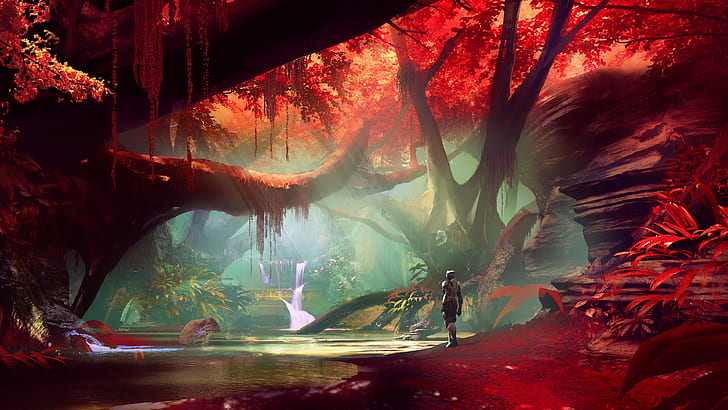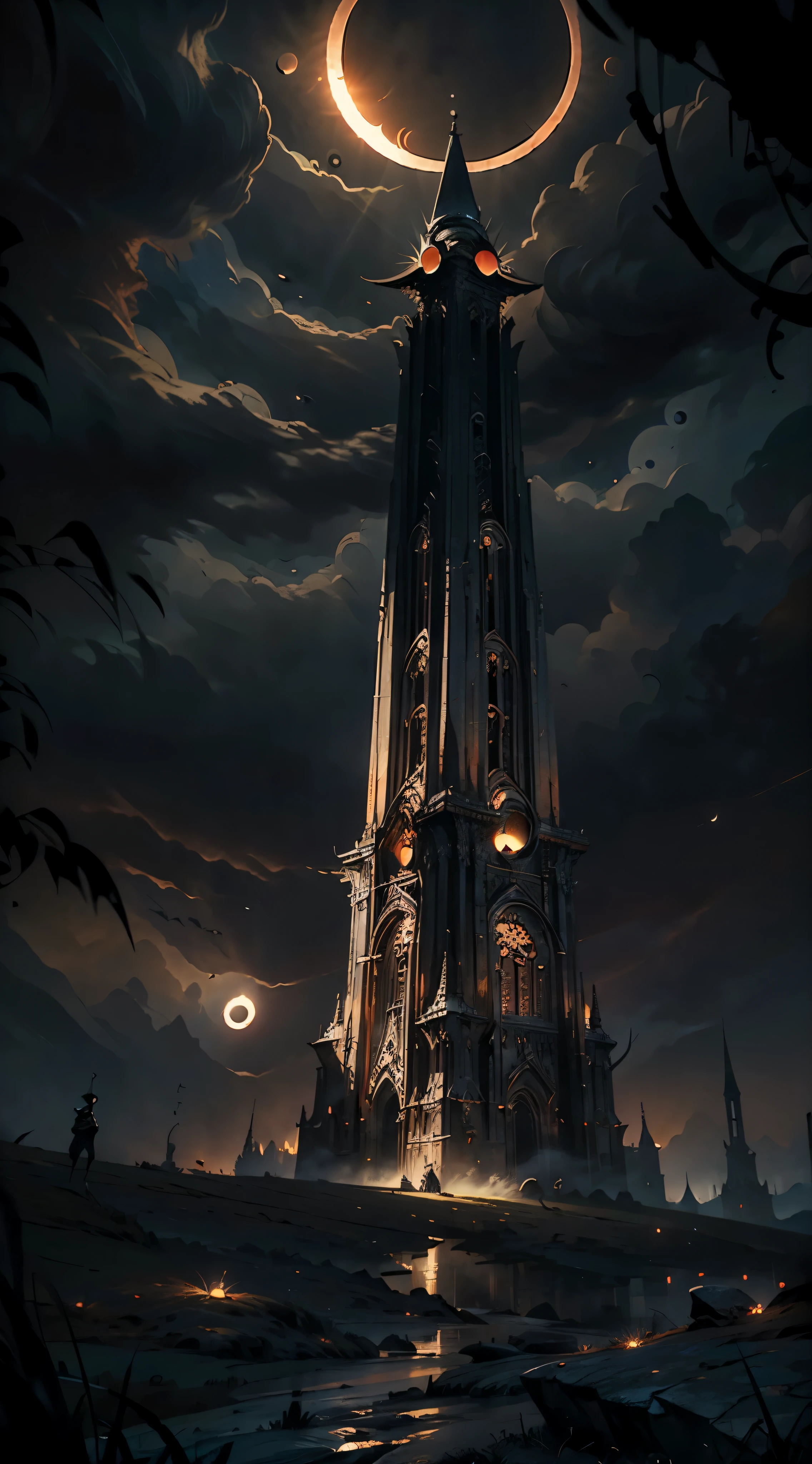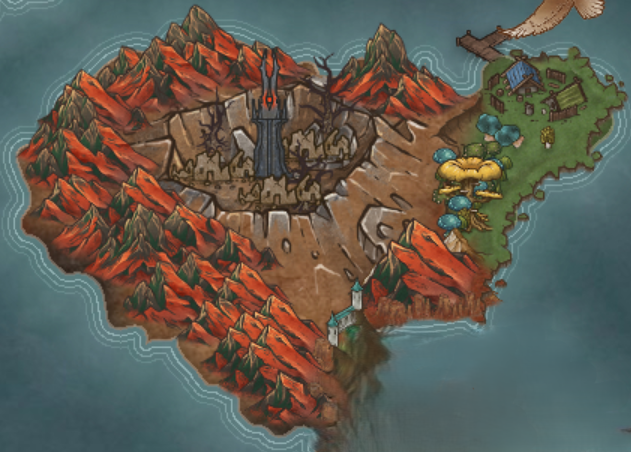The Northern Expanse
The Northern Expanse of Lys Verdan is a land cleaved by contrast half a tapestry of care and cultivation, half a wound that refuses to heal.
To the east, the Vale of Tiderun and its outlying farmlands offer a vision of pastoral resilience: halfling clans bound by work, tradition, and the enduring reverence of the Wanderer. Here, rolling fields yield golden harvests, underground tunnels guard the valley’s roots, and southern forests dense, musical, and alive are tended by druids who remember the world before it broke. These lands speak of stewardship, discipline, and the quiet strength of small hands holding back great dangers.
But to the west, the land grows black and brittle. The scorched crater of Sol Cindareth, once a shining elven city of fire and indulgence, now rots beneath the obsidian shadow of the Black Spire, a monument to hubris, pact, and the slow draining of life. The living hold the line at Sulgrave, their muskets and cannons pointed outward against the creeping dead. Beyond them, the Shardspine Mountains rise like jagged memories, home to monsters, Oblivion cults, and a dragon that bleeds silence. In the Northern Expanse, light and shadow are not just forces they are neighbors. And between them lies a fragile line walked by rangers, dreamers, and those who have nowhere else to go.
The Vale of Tiderun is a sun-dappled ribbon of land descending gently to the sea, a valley town layered like a tapestry with meaning. Carved into the slopes in multiple terraces, winding bridges span the vale’s open heart like ribbons of trust, linking each level in quiet harmony. At the end of the valley lies a great stone dock, bustling with trade, save for the ancient Fisher’s Pier at its center kept clear in reverent silence for the Wanderer, the divine guide said to walk these lands in mortal form. Though its people are small in stature, the culture of Tiderun is large in heart, defined by ritual, communal bonds, and a deep belief that no one should ever walk the road alone.
To the south of the Vale, where the land flattens into wide fields and sun-soaked horizons, lies Goldenmere, a farming region named for the shimmering lake that rests at its heart. Unlike the ritual-woven terraces of Tiderun, Goldenmere is a place of discipline, toil, and unspoken pride. The halflings here do not revere the Wanderer as divine but respect the land itself as sacred, while the town of Goldenmere serves as the region’s central hub: part market square, part granary, part town hall. Though rural and sparse compared to Tiderun, Goldenmere is no less vital, guests are met with warm bread, clear expectations, and the quiet certainty that every honest hand has a place here.
To the west of Goldenmere. Beneath the Eastern hills run the Deepwatch Paths, ancient tunnels carved long ago and now fiercely maintained by rangers of the Wayfarer order. Most of the network lies sealed or collapsed, save for three vital corridors that funnel trade, travelers, and threats alike beneath the surface. These dark, mushroom-lit passages are lifelines and battlegrounds, where rangers harvest rare medicines and slay what should never reach the valley above. At their heart lies a hidden fortress and training ground—a last redoubt where steel, silence, and memory hold the line. Yet on the western exits, strange shrines to Oblivion have begun to appear, marking a quiet rot in the stone.
To the south of Goldenmere lies Amo-te, a forest steeped in old magic and older caution. Managed by halfling druids who remember the world’s near ending, the woods are sacred but tightly watched. Waystones line the borders to prevent its spread, turning back the weak-minded who wander too close. At its heart rests Dancers Hollow, a village grown rather than built, where music flows like breath and druids live as beasts to better hear the forest’s voice. Amo-te is beautiful, yes but always wary. Deep within, a sealed cave lies under ancient ward and fang, a secret too dangerous to forget.
To the west of the greenlands, past the Deepwatch paths and further west is a massive crater which rests a destroyed city. Once called the jewel of elven ambition, Sol Cindareth now lies shattered within a blackened crater, its gold spires twisted, its song forever silenced. Built on passion, magic, and a pact with a fire-born titan, the city fell during the great war when a stranger’s gift the Black Spire drained all life to halt an advancing horror. Now, its streets are ruled by undead mages who reenact grotesque parodies of art and love with puppet corpses as their canvas. Beauty rots here, suspended in endless performance, waiting to devour the next soul that dares admire it.
Perched on the crater’s edge, Sulgrave is a walled town built from necessity, grit, and gunpowder. Cannons line its battlements, and soot-streaked watchmen scan the ash horizon for movement from the ruins below. Its people, a hardened mix of humans, elves, and others, survive by salvaging gold and silver from the bones of Sol Cindareth, and mining sulfur from the scorched earth. Food is imported, tempers are short, and sleep is never easy but Sulgrave endures, a final outpost between the living and the rot that waits beyond the gate.
The Shardspine Mountains rise like shattered blades around the western crater, their peaks jagged and cruel. Once rich with mithril, the range is now cursed home to a corrupted dragon and the ruins of a mining town overrun by Oblivion cultists. Twisted beasts prowl its snows, and echoes speak in voices not your own. Smugglers and desperate travelers risk its hidden trails, often guided by the elusive Hollow Teeth, but even the Wayfarers treat it with reverence and dread. In Shardspine, the path is never safe only less deadly.





Comments